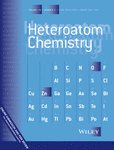Clean Procedure for the Synthesis of Α-Aminophosphonates Catalyzed by Choline-Based Ionic Liquid
Contract grant sponsor: Ministry of Science and Technology of the P.R. China.
Contract grant number: 11C26213201395.
Contract grant sponsor: Nature Science Foundation of Jiangsu Province.
Contract grant number: BK20141257.
Contract grant sponsor: Key Laboratory of Organic Synthesis of Jiangsu Province.
Contract grant number: KJS1112.
Contract grant number: Professional Elite Foundation of Yancheng Normal University.
ABSTRACT
A sulfated choline-based ionic liquid [Ch-OSO3H] was prepared and used as a novel catalyst for the synthesis of α-aminophosphonates via a one-pot three-component reaction with aldehydes, amines, and triethyl phosphite/diethyl phosphite at room temperature under solvent-free conditions or in aqueous media. The reaction was completed in short times and products could be simply separated from the reaction mixture in good to excellent yields. The catalyst could be recycled and reused for several times without noticeably reducing catalytic activity.




